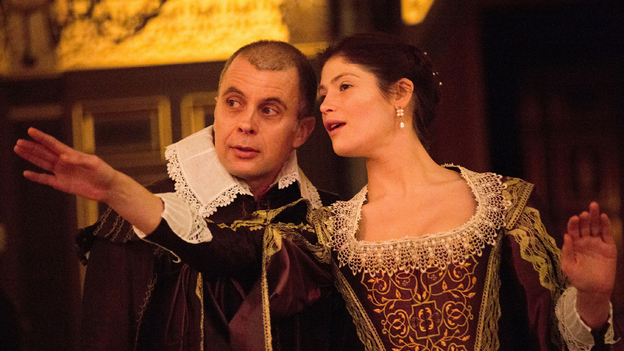
May 25, 2014, by Peter Kirwan
The Duchess of Malfi (Shakespeare’s Globe) @ BBC4
In a new age of broadcast theatre where the prices for NT Live and Live from Stratford screenings are creeping up (and where the Globe’s own DVDs are still shockingly expensive), it is refreshing and welcome to see The Globe broadcasting its major production of The Duchess of Malfi for free on BBC4. This is, of course, one of the best marketing tools for the (relatively invisible) Sam Wanamaker Playhouse that could be imagined. Prefaced by a James Shapiro documentary on John Webster – he talks! He walks around historical sites! He points at objects! – that in fact served as a feature-length advertisement for the Globe’s work, the film sheds (flickering) light on a venue that many audiences are undoubtedly still only partially aware of. This is, of course, not a complaint. It’s cheering to see the BBC collaborating in such a major way with the theatre to bring an event production to the widest possible audience.
In mine and Christie Carson’s forthcoming Shakespeare and the Digital World (copies apparently arriving at CUP on June 3rd!), Steve Purcell discusses the Globe’s first broadcast of Richard II starring Mark Rylance, introduced by Andrew Marr. Marr returned here, making the frustrating observation that the Duchess is a ‘sexy and attractive heroine’. It’s a little frustrating that, of all the qualities to single out, it’s the blurred line between the actor and the character’s physical appearance that was highlighted. And the obvious Tarantino comparisons (used both by Marr and in the Shapiro documentary) increasingly frustrate me for their lack of specificity – to reduce Webster to comic violence (which seems to me to be what is meant by the comparison) is to lose the nuance of Webster’s craft, as my dissertation student has cogently argued. It was a little alarming, too, to be confronted by Marr’s face again at the end of Act 3, with an ‘interval’ feature that previewed and explained what was about to happen. Given that the interval wasn’t even long enough to make a cup of tea, I have to wonder what the point was in having this at all.
These gripes aside, this was a tremendous film of Dominic Dromgoole’s production, which I enjoyed far more than the live performance, partly because the acoustic problems had been resolved in the mix, and partly because the close proximity of the cameras gave access to the nuance of facial expression that was lost to me in the glare of the naked flames. Darting all around the auditorium, including facing the audience, the screening showed off the intimate space to best possible effect, lending a dynamism that motivated and energised the stately performance.
The central set piece worked very interestingly on camera. The long, absolute black out in which the Duchess held a severed hand was a disconcerting moment on television, and oddly effective despite giving nothing but voices to respond to. The subsequent reveal of the wax dummies was far less effective – the camera wisely kept its distance so as to keep the status of the figures ambivalent, but it seemed oddly unspectacular, and I didn’t manage to glimpse the discarded hand at all, which yet again points up the silliness of having the scene played in absolute black, however much this allows the playhouse’s capabilities to be shown off. The better balance of the sound mix for the recording was also to the production’s benefit, ensuring that the leads weren’t too loud and that no-one was drowned out by the incessant twinkly music.
I won’t review the production again, but the whole company came off well, most notably David Dawson’s tremendous, tormented Ferdinand and Denise Gough’s sneering, breathy Julia. Interestingly, while the close proximity of the cameras allowed for greater emotional heft in the main plot (notably being able to see the nuances in Gemma Arterton’s alabaster-still performance), it was the comedy of Dawson’s guffawing and ravings; of Gough’s lustful glances at Bosola; and of John Dougall’s wry Doctor that worked best. I hope this is a good sign that the format will work well for The Knight of the Burning Pestle, should the Globe decide to film that when it is revived next year.
This snappy, lively production worked fantastically on television, with the Sam Wanamaker looking not only beautiful but also providing a perfect framing for the actors. If this is the beginning of a fresh relationship for the Globe and the BBC, it’s a promising start and a classy programming move, and hopefully will be used to show a variety of uses of the space rather than just the big prestige Jacobean tragedies.
No comments yet, fill out a comment to be the first

Leave a Reply